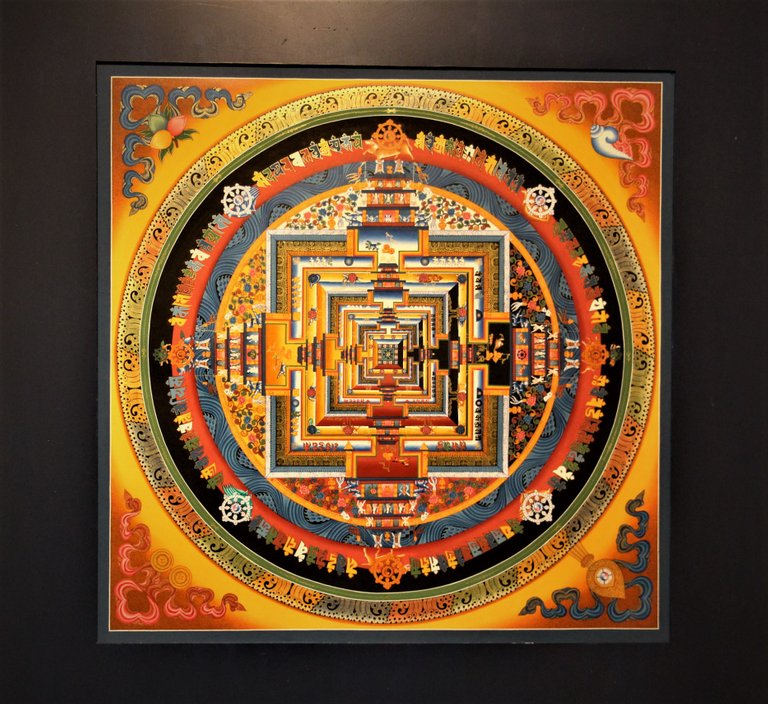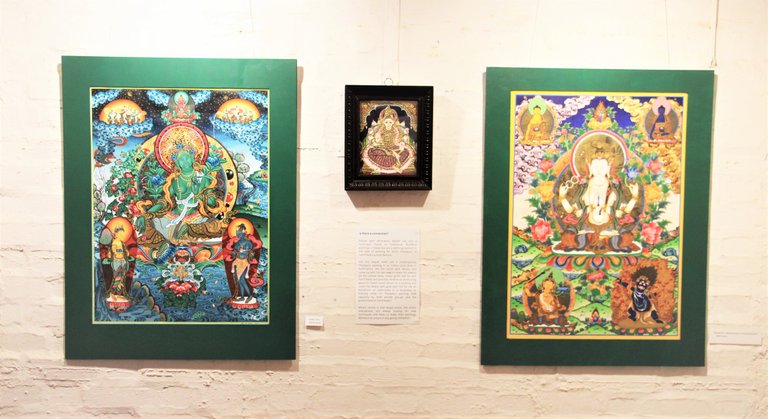
Kalachakra
Painting Traditions in the Kathmandu Valley, Nepal
Stone sculpture in the Kathmandu valley of Nepal can be dated back to the 1st and 2nd centuries and woodcarving to the 7th century but wall paintings and paintings on cloth have not Survived the frequent 11th and 12th-century manuscripts The earliest Nepali painting on cloth has been dated to the late 11th century.
The Hindu and Buddhist iconography and style of these paintings can be traced to the patronage of the Gupta ad pala dynasties in establishing the great Buddhist centers of learning in what is, today, North India and Bangladesh. From the 7th century onwards, Chinese Buddhist influence, filtered through Tibet, and by direct contact with Chinese Buddhist monks ViSiting the sacred sites of Buddhism in South Asia resulted in a unique style of the painting by the Newari artists of the Kathmandu Valley. Characterized by elegant composition, luminous
colors, exquisite detail, and red backgrounds of swirling patterns of cosmic energy this style came to dominate the art of central and eastern Tibet from the 13th to 18th centuries.
Newari painters and sculptors were frequently summoned to Tibet by the abbots of new monasteries and many settled permanently in Lasa and other centers of Buddhist learning to meet the demand for paintings and required by Buddhists for teaching daily rituals, and personal meditation. Most of the earliest Nepali paintings now museums and personal collections around the world survived the centuries due to the cool and dry climate in Tibet and were carried out of Tibet when Buddhist monks fled across the Himalayas during the Chinese Cultural Revolution in the 1960s.
From the late 60s to the present day, the establishment of new Buddhist monasteries and centers of learning in Nepal, India, ànd around the world has led to a worldwide interest in Buddhism and the need tor the paintings and sculptures so vital to the teaching of Buddhism to new adherents who, in turn, have created à growing need for Buddhist art.
Suppressed by orthodox Hindu rulers following the conquest of the Kathmandu valley by the shah dynasty in 1739, Buddidst art in Nepal has experienced a renaissance that began in the late 70s as artists began to rediscover their own cultural heritage. Many artists with fine arts degrees from colleges that focused on western art concepts and techniques have turned to traditional artists to master the techniques and iconography o Buddhist religious painting.
The artists represented in this exhibition now move effortlessly between the creation of classical Newari påinting and the incorporation of traditional elements or Buddhist iconography to their contemporary works. In this exhibition, you can not only see their paintings but meet the artists and in-wall texts read in their own words how and why they became artists and why despite the many difficulties financial and otherwise, they have dedicated their lives to their art and to the preservation of the culture that inspires them.
Now I am going to share some interesting thoughts. In Nepal, there are not only individual artists but also some groups or family of artists they work together to complete any paintings. In those groups, there is separate work distributed to all the artists in that group. They are masters in their own work. Some only daw the face, some do only jewelry work and some do only the finishing touch. This how they work together to produce a wonderful painting. Now I am going to share one of the family artwork with all of my Hive friends.

Is there a connection?
Raised gold decorative details are not a technique found in traditional Buddhist paintings in Nepal but are a defining element in the style of painting for which Thanjavur, in Tamil Nadu is most famous.
Did this Nepali artist see a contemporary Thanjavur painting in an Indian curio shop in Kathmandu, like the raised gold details, and come up with his own way to make the jewelry on his central deity raised gold? Did he visit Tamil Nadu and possibly observes an artist using gesso to create raised details on painting and cover the details with gold leaf? Did he see an exhibition, or participate in a workshop or training camp on Thanjavur painting held
regularly by both private groups and the government of Tamil Nadu? What's certain is that Nepal artists, like artists everywhere, are always looking for new techniques and ideas to make their paintings stand out as unique in any group exhibition.
Have a lovely day. Thanks for reading my article. Please stay home and stay safe from Coronavirus(COVID-19).
You post has been manually curated by BDvoter Team! To know more about us please visit our website or join our Discord.
Are you a Splinterlands player? If Yes, then checkout MonsterMarket.io. Get instant 3% cashback on every card purchase, and 2% cashback on every booster pack purchase on MonsterMarket.io. MonsterMarket has the highest revenue sharing in the space - 60% for cards and 40% for packs, no minimum spending is required. Join MonsterMarket Discord.
BDvoter Team